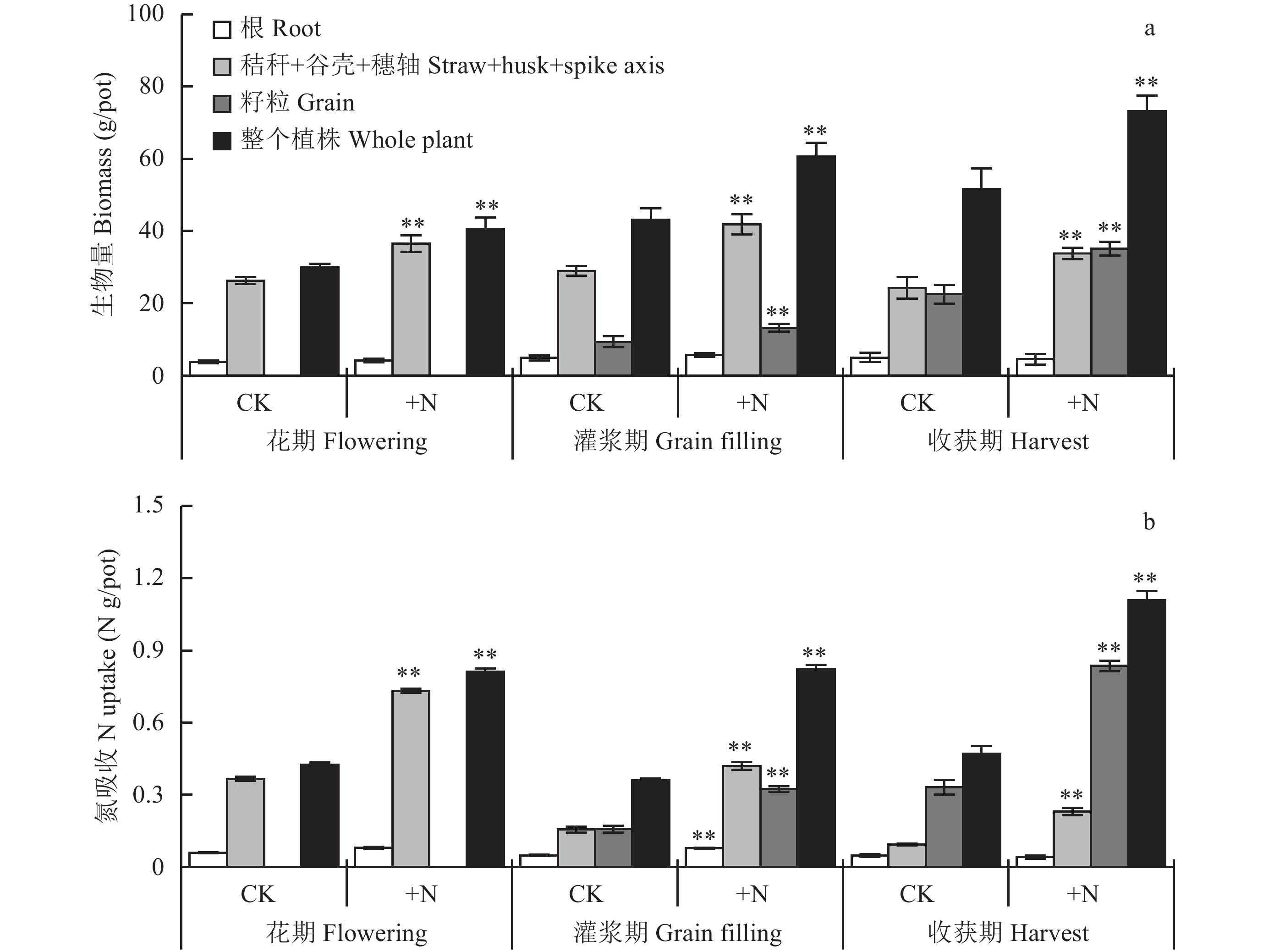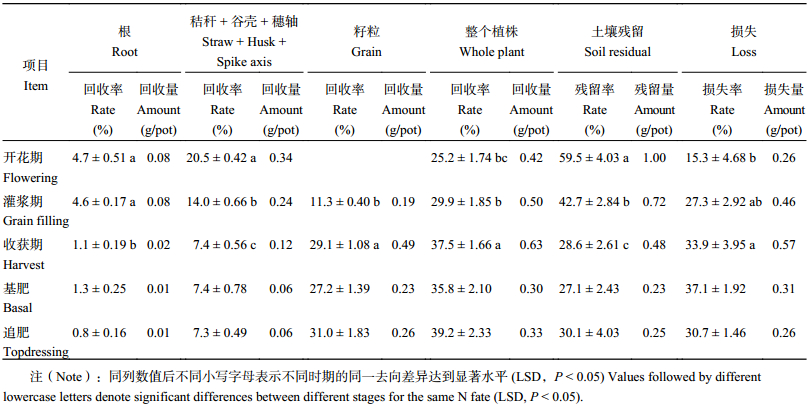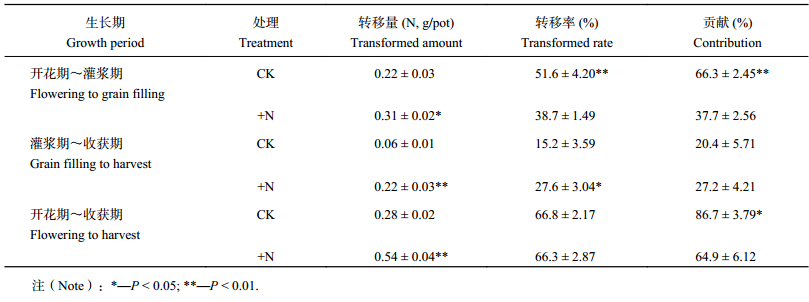化肥氮的去向包括作物吸收、土壤残留和损失。氮肥利用率是指当季作物吸收肥料氮占施入肥料氮的百分比,反映的是当季作物对肥料氮的回收情况,并未考虑氮肥后效和残留肥料氮对土壤氮消耗的补偿这一重要的氮素转化问题[1–2]。目前,作物对氮肥的吸收比例和数量主要采用差值法和同位素示踪法来确定,从理论上也可应用这两种方法测定化肥氮的土壤残留率和残留量[3]。田间试验中,由于土壤氮库很大,30 cm土体一般为N 3000~5000 kg/hm2[3],通过肥料施入的氮量较小 (单季N 100~300 kg/hm2)[4],作物收获以后,残留在土壤中的肥料数量只有N 100~200 kg/hm2[3],导致施肥区和对照区土壤氮量差的准确测定较为困难,给差值法带来较大误差。相对而言,15N示踪法能够较准确测定氮肥的利用率[3, 5–6]。
冬小麦生产中,肥料氮的去向受土壤肥力[7]、作物品种[8]、产量水平[9]、施氮数量[10–11]和施氮时期的影响[12–15]。一般情况下,随着施氮量增加,氮肥利用率和土壤残留率降低,损失率显著增加[10–11]。对于施肥时期,由于氮素转化高度活跃 (包括氨挥发、硝化/反硝化以及淋溶等),一般分开施肥比一次性施肥氮肥的利用率更高[14, 16]。在华北平原,石玉等[14]和Ju等[15]都发现,追肥氮的利用率显著高于底肥氮,损失率则低于底肥氮。López-Bellido等[17]在西班牙砂姜黑土区的研究也得到同样的结果,拔节期施肥的利用率较高。需要指出的是,大部分研究仅针对氮肥利用率,没有考虑肥料氮在土壤中的残留,即对于土壤氮库的补偿效应。
采用15N示踪法,可以定量冬小麦吸收氮的来源,即来自肥料氮和来自土壤氮的数量。若来自土壤的氮量大于肥料氮的残留量,就说明残留的肥料氮不能维持土壤氮库的平衡;反之,残留的肥料氮可以维持土壤氮库的平衡。差值法不能区分冬小麦吸收氮的来源,因此无法比较残留肥料氮和作物吸收的土壤氮[1]。因此,15N示踪法可以较好地反映施肥对于土壤氮库的补偿效应。近年来,随着我国粮食生产水平的提高,氮肥用量不断提高。以前研究所获得的氮肥去向[18–20],无法准确反映当前生产水平下,氮肥在土壤和作物系统中的分配和转换。为了进一步明确肥料氮–土壤氮–作物氮“三氮”之间的关系,改进小麦生产中的氮素管理,提高施氮效果,降低对环境的负面影响,本研究分期 (冬小麦播期或拔节期) 施肥,采用15N示踪法,分析当前农民氮肥水平下,肥料氮的利用率、对于土壤氮库的补偿效应以及肥料氮的损失。
1 材料与方法 1.1 试验地概况试验于2014年10月15日至2015年6月5日在中国农业大学桓台实验站田间进行。该站位于东经117°59'、北纬36°57',海拔高度为18 m。供试土壤取自试验站农田表层 (0—20 cm)。供试土壤为潮土[21]:土壤有机碳8.4 g/kg、土壤无机碳5.2 g/kg、全氮0.67 g/kg、pH = 8.2 (水土比为2.5∶1)、有效钾174 mg/kg、速效磷5.2 mg/kg。
1.2 试验设计 1.2.1 盆栽试验设计采用内径10 cm、高30 cm的PVC钵进行盆栽试验。每盆装过5 mm筛的风干土8.7 kg。试验为两因素随机区组设计,4次重复。不同时期破坏性取样为A因素,设花期、灌浆期和收获期3个水平。施氮量为B因素,设不施氮 (CK) 和施氮 (+ N,N 90 mg/kg,即等同于当地农民常规施氮量N 250 kg/hm2) 两个氮肥水平,分别以50%作基肥、50%在拔节期追肥,氮肥用15N标记尿素。所有处理均以过磷酸钙和硫酸钾作底肥,用量分别为P2O5 78 mg/kg和K2O 43 mg/kg。用称重法控制土壤水分为田间持水量的75%。供试作物为冬小麦 (Trticum aestivums L.),品种为鲁源502。播种前,小麦种子放在清水中浸泡10小时,然后再浅埋入土壤中。2014年10月15日播种,每盆10粒,出苗一周后,每盆留6株 (根据田间定植密度1.8 × 106株/hm2)。冬小麦生长期间,根据病虫害情况,喷洒必要的农药。
1.2.2 15N标记采用原子百分含量为10.4%的15N标记尿素 (由上海化工研究院生产)。对于开花期和灌浆期取样的小麦,基肥和追肥均采用15N标记尿素。对于收获期取样的小麦,通过设“基施15N标记尿素 + 拔节期追施普通尿素”和“基施普通尿素 + 拔节期追施15N标记尿素”两种施肥方式,来研究收获期基施和追施肥料氮的去向[12, 22]。基肥和追肥的比例为1∶1,每盆分别各施入0.84 g 15N标记尿素或者普通尿素 (含氮量为46%)。具体步骤为:把尿素溶于盛放200 mL去离子水的烧杯中,溶解完全后缓缓倒入小部分土壤中,再与剩余的大部分土壤混匀。同时,设置施普通尿素 (自然丰度) 的对照盆,每个处理重复4次。
1.2.3 取样与分析分别在开花期 (播种后196天)、灌浆期 (播种后216天) 和收获期 (播种后230天),于CK和 + N (15N肥料标记和自然对照不标记) 两个处理盆中破坏性取样,并按根、秸秆+谷壳+穗轴、籽粒进行区分。从基部剪断小麦植株,将全部土壤过2 mm筛,挑出根系,把土壤平铺于农用地膜上。把挑出的根连同附着于根上的土壤用水浸泡,轻轻振荡,20 min后,过1 mm筛,把筛上根冲洗干净。然后把浸泡和冲洗小麦根的用水、沉淀的泥浆均匀地洒在平铺于地膜上的土壤中。将土壤用多次四分法方式缩分,最后取约50 g土壤。将小麦地上部和根分别置于105℃下杀青30 min,60℃下烘干至恒重。从50 g土壤样品中取约20 g土壤置于白色平板上,挑去残留细根,在60℃条件下烘干至恒重。
测定之前,利用球磨仪 (Restol MM2000,Retsch,Haan,Germany) 研磨 (< 500 μm)。上述各类样品的15N丰度,分别在DELTAplus XP型质谱仪 (DELTAplus XP,ThermoFinnigan,Bremen,Germany) 中测定。利用Thermo Elemental Analyzer 1112元素分析仪测定植物氮含量和土壤全氮含量。
1.2.4 氮素相关指标的计算方法冬小麦吸收的氮中,来自肥料氮和土壤的比例 (%) 和数量 (N g/pot)[10–11]用下列公式计算:
| $\begin{aligned}{\text{冬小麦氮素来自肥料氮的比例}}\left( {{\%}} \right) =\quad\quad\quad\quad\quad\quad\quad\quad\\\frac{{{\text{各器官氮的}}{^{15}}{{N}}{\text{原子百分超}}}}{{{\text{肥料氮的}}{^{15}}{{N}}{\text{原子百分超}}}} \times 100 \quad\quad\quad\end{aligned}$ | (1) |
| $\begin{aligned}{\text{冬小麦氮素来自土壤氮的比例}}\left( {{{\%}}} \right) =\quad\quad\quad\quad\quad\quad\quad\quad\quad\quad\quad\quad\quad\\100 - {\text{来自肥料氮的比例}}\quad\quad\quad\quad\quad\quad\quad\quad\end{aligned}$ | (2) |
| $\begin{aligned}{\text{冬小麦氮素来自肥料氮的数量}}\left( {{{N}}, {{g}}/{{pot}}} \right) =\quad\quad\quad\quad\quad\quad\\ {\text{各器官的氮吸收量}} \times {\text{来自肥料氮的比例}}\left( {{{\%}}} \right)\quad\quad\quad\quad\end{aligned}$ | (3) |
| $\begin{aligned}{\text{冬小麦氮素来自土壤氮的数量}}\left( {{{N}}, {{g}}/{{pot}}} \right) =\quad\quad\quad\\ {\text{各器官氮吸收量}} - {\text{各器官来自肥料氮的数量}}\quad\end{aligned}$ | (4) |
土壤氮素来自肥料氮的比例 (%) 和数量 (N, g/pot)[3, 5]:
| $\begin{aligned}\;\;{\text{土壤氮素来自肥料氮的比例}}\left( {{\%}} \right) =\quad\quad\quad\quad\quad\quad\quad\quad\quad\\\frac{{{\text{土壤氮的}}{^{15}}{{N}}{\text{原子百分超}}}}{{{\text{肥料氮的}}{^{15}}{{N}}{\text{原子百分超}}}} \times 100\quad\quad\quad\end{aligned}$ | (5) |
| $\begin{aligned}{\text{土壤残留的肥料氮数量}}\left( {{{N}},\;{{g}}/{{pot}}} \right) ={\text{土壤质量}} \times\\\;\;{\text{土壤含氮量}} \times {\text{土壤氮素来自肥料氮的比例}}\end{aligned}$ | (6) |
冬小麦对肥料氮的回收率 (%)、肥料氮在土壤中的残留率 (%) 和损失率 (%)[10–11, 23]分别用下列公式计算:
| $\begin{aligned}{\text{肥料氮的回收率}}\left( {{{{\%}} }} \right) =\quad\quad\quad\quad\quad\quad\quad\quad\quad\quad\quad\\{\text{冬小麦氮素来自肥料氮的数量}}/{\text{施氮量}} \times 100\end{aligned}$ | (7) |
| $\begin{aligned}{\text{肥料氮的残留率}}\left( {{{{\%}} }} \right) =\quad\quad\quad\quad\quad\quad\quad\quad\quad\quad\quad\\{\text{土壤残留的肥料氮数量}}/{\text{施氮量}} \times 100\end{aligned}$ | (8) |
| $\begin{aligned}{\text{肥料氮的损失率}}\left( {{{{\%}} }} \right) =\quad\quad\quad\quad\quad\quad\quad\quad\quad\quad\quad\\100 - {\text{肥料氮的回收率}} - {\text{肥料氮的残留率}}\end{aligned}$ | (9) |
冬小麦营养器官的氮转运量用灌浆前 (开花期) 和灌浆后 (灌浆期和成熟期) 营养器官中氮素之差来表示 (N, g/pot),转运效率是冬小麦氮转运量占开花期营养器官氮量的百分比 (%),小麦氮素转运对籽粒的贡献为开花后营养器官氮素转运量占成熟期籽粒氮量的百分比 (%)[24–26]:
| $\begin{aligned}&{\text{营养器官的氮转移量}}\left( {{{N}}, {{g}}/{{pot}}} \right) =\quad\quad\quad\quad\\&\quad{\text{营养器官的氮}}{{\text{量}}_{{\text{开花期}}}} - {\text{营养器官的氮}}{{\text{量}}_{{\text{灌浆后}}}}\quad\quad\quad\quad\end{aligned}$ | (10) |
| $\begin{aligned}\;{\text{营养器官的氮转移效率}}\left( {{{{\%}} }} \right) =\quad\quad\quad\quad\quad\quad\quad\quad\quad\quad\quad\quad\quad\quad\;\;\\\frac{{{\text{营养器官的氮转移量}}}}{{{\text{营养器官的氮}}{{\text{量}}_{{\text{开花期}}}}}}\times {{100}}\quad\quad\quad\quad\quad\quad\quad\end{aligned}$ | (11) |
| $\begin{aligned}&{\text{贡献}}\left( {{{{\%}} }} \right) =&\frac{{{\text{营养器官的氮转移量}}}}{{{\text{籽粒的氮}}{{\text{量}}_{{\text{成熟期}}}}}} \times {{100}}\quad\quad\quad\quad\quad\quad\end{aligned}$ | (12) |
对不同生育期 (A因素) 试验数据采用SPSS17.0软件中的单因素AVNOVA进行方差分析,采用LSD法进行多重比较;对不同氮肥用量 (B因素) 试验数据采用SPSS17.0软件中的t-test进行方差分析。
2 结果与分析 2.1 供氮对冬小麦各器官生物量和氮吸收的影响除冬小麦根生物量和根氮吸收量外,其他器官和整个植株的生物量和氮吸收量,+ N处理均显著高于CK (图1)。仅在灌浆期,+N处理的根氮吸收量显著高于CK,其余生育时期两处理间无显著差异 (图1b)。
 |
| 图1 供氮对冬小麦各器官生物量 (a) 和氮素吸收 (b) 的影响 Fig. 1 Effects of N supply on biomass (a) and N uptake (b) in winter wheat organs [注(Note):星号表示同一生育期不同处理的小麦生物量和氮吸收量达到显著水平 (t-test, *— P < 0.05, **—P < 0.01) Asterisks denote significant differences (t-test, *—P < 0.05, **—P < 0.01) of biomass and N uptake between CK and +N treatments at the same stage.] |
在冬小麦收获期,土壤氮对根氮的贡献最大 (57.2%),对籽粒氮的贡献最小 (42.8%)(图2a);相反,肥料氮对籽粒氮的贡献最大 (58.4%),基肥氮和追肥氮的贡献分别为27.3%和31.1%,肥料氮对根氮的贡献最小 (42.7%),基肥氮和追肥氮的贡献分别为25.8%和16.9%(图2a和图2b)。肥料氮对整个植株氮的贡献为57.2%,基肥氮和追肥氮的贡献分别为26.6%和30.6%。对于冬小麦各器官和整个植株,土壤氮的贡献均显著高于基肥和追肥氮,基肥和追肥氮对小麦器官 (除根之外) 氮贡献没有显著差异 (图2)。
 |
| 图2 基肥、追肥和土壤氮对冬小麦氮吸收的贡献 Fig. 2 Contribution of basal fertilizer N, topdressing fertilizer N and soil N to winter wheat N [注(Note):S + C + H是指秸秆 + 谷壳 + 穗轴 Straw + Husk + Spike axis.] |
肥料氮进入冬小麦–土壤体系后,主要有3种去向,即,被作物吸收、在土壤中残留以及各种途径损失。从冬小麦开花期到收获期,整个植株对肥料15N的回收率约提高了50%,而营养器官 (根和秸秆 + 谷壳 + 穗轴) 对肥料15N的回收率下降了60% (表1)。在开花期,营养器官对肥料15N的回收率高于籽粒,到了收获期,籽粒对肥料15N的回收率却高于营养器官 (表1)。这是因为从开花期到成熟期,冬小麦籽粒氮的64.9%~86.7%由开花期营养器官的储存氮素转运而来,从开花期到灌浆期和灌浆期到成熟期两个阶段转运的氮量,分别占到成熟期籽粒氮的37.7%和20.2% (表2)。从开花期到成熟期,与CK相比,+N处理显著地促进了营养器官氮素向籽粒的转运量 (增加了93%),降低了营养器官氮素对籽粒的贡献,降低了25% (表2)。
从开花期到收获期,15N标记氮肥在土壤中的残留率随冬小麦生长而降低,下降了约50% (表1)。在收获期,残留的肥料15N为N 0.48 g/pot (表1) 和冬小麦吸收的土壤氮N 0.47 g/pot之间没有显著差异 (结合图1b和图2c计算),因此,肥料可以完全补充本季小麦对土壤氮肥力的消耗。肥料15N的损失率随着冬小麦的生长而升高,从开花期到收获期,升高幅度甚至达两倍。
| 表1 冬小麦不同生育期肥料氮的去向 Table 1 Fate of fertilizer N at different wheat growth stages |
 |
在冬小麦收获期期,整个植株对基肥和追肥肥料15N的回收率分别为35.8%和39.2%,两者之间没有显著差异,各个器官对基肥和追肥15N的回收率也没有显著差异。基肥和追肥15N在土壤中的残留率分别为27.1%和30.1%,两者之间没有显著差异。追肥的15N标记肥料氮损失率显著低于基肥21% (表1)。
| 表2 冬小麦开花后营养器官向籽粒的氮素转移 Table 2 Translocation of N from vegetative organs to grain after anthesis stage of wheat |
 |
小麦氮有2个来源,来自土壤的氮和肥料的氮。本研究中,冬小麦整个生育期吸收的肥料氮占总吸氮量的57%,土壤氮占43%,肥料氮高于土壤氮 (图2),这与Jia等[12]的结果类似,肥料氮对冬小麦氮的贡献高于55%。在大多数研究中,土壤氮对小麦氮的贡献高于肥料氮,如左红娟等[26]在华北平原的研究表明,土壤氮对冬小麦氮贡献为66%~73%,与边秀举等[27]在草甸栗钙土上测得的结果类似 (69%~77%)。本研究和其他研究结果不同,可能与本研究土壤处于中低氮肥力水平、小麦对肥料氮的依存率相对较高有关[7, 29]。达到一定施氮量,提高施氮量只增加肥料氮的吸收比例,但不能提高小麦氮吸收量,这也是高土壤肥力下过量施氮不能提高产量的原因[29]。无论土壤肥力高低,土壤氮在小麦生产中仍然起到非常重要的作用 (贡献率 > 40%),因此,加强土壤肥力培育,对于冬小麦高产和稳产具有重要意义。
基肥和追肥对冬小麦氮贡献无显著差异 (图2),这与边秀举等[28]在草甸栗钙土上的结果类似。而其它研究发现,追肥氮对小麦氮的贡献显著高于基肥氮[12–13, 30]。基肥和追肥氮对小麦氮的贡献主要与3个因素有关:1) 追肥时期,相同追肥氮量下,拔节期追肥氮对小麦氮的贡献高于返青期[24];2) 底肥和追肥比例,比例不同也会造成贡献不同,当1/3为基施尿素时,2/3为追施尿素时,追肥氮对小麦氮的贡献是基肥氮的2倍[28];3) 施氮量在N 240 kg/hm2的施肥水平下,追肥和基肥氮对小麦氮的贡献显著高于N 120 kg/hm2[29]。
冬小麦籽粒获得氮有2个途径,一是直接来自根系的吸收,二是冬小麦开花期之前营养器官氮的再运转和利用[31]。本研究中,小麦开花期后营养器官氮的贡献为65%~87%,只有13%~35%的籽粒氮是靠根系吸收供应的 (表2)。同延安等[32]也发现了类似结果,冬小麦营养器官转运氮对籽粒氮的贡献为69%~87%,只有13%~31%的冬小麦籽粒氮是由根系直接吸收。因此,在营养生长阶段,冬小麦吸收超过其满足其当前组织需要的氮量并储存起来,然后在后期生殖生长阶段转运存储的氮素到籽粒[33–34]。
3.2 化肥氮的去向籽粒吸收肥料氮的多少决定了氮肥的经济利用效率。本研究中,籽粒吸收的肥料氮约是秸秆的4倍,与左红娟[27]的15N标记冬小麦结果相近,表明冬小麦吸收的肥料氮优先分配于籽粒中。冬小麦对肥料氮的回收率一般随施氮量的增加而减少[13, 35],但取决于施氮量的范围。如当施氮量从100增加到250 kg/hm2,对肥料氮的回收率无显著差异[36],这是由于施氮量增加仅提高了冬小麦吸收肥料氮的比例,而不改变小麦氮吸收总量 (土壤氮 + 肥料氮)[10–11]。冬小麦收获期,肥料氮的损失率为34%,基肥氮的损失率比追肥氮高21% (表1)。和王月福等[29]的结果相似。这意味着,在本研究中农民常规施肥为N 250 kg/hm2的水平下,适当增加追肥氮的比例可以减少其损失率。
未被小麦吸收的肥料氮,还以各种形式残留在土壤中,本研究结果为29% (表1),这部分是消耗土壤氮库的重要补充。氮肥利用率不可能无限制提高,施入土壤中的氮肥总有一部分在土壤中残留和以各种损失[37]。从另一个角度分析,无论何种施肥措施,土壤氮对冬小麦氮的贡献一般为60%以上,氮素残留实际上是肥料氮与土壤氮的交换[12–13, 30]。本研究中,整个小麦生育期,土壤氮素消耗 (N 0.47 g/pot) 约等于肥料残留氮 (N 0.48 g/pot),土壤氮肥力能够维持基本平衡。
4 结论1) 在冬小麦整个生育期,肥料氮对小麦氮的贡献为主 (57%),基肥和追肥的贡献分别为26%和31%,土壤氮的贡献为43%;从开花期到成熟期,籽粒氮中的64.9%是由开花期营养器官的氮转运而来;从开花期到灌浆期和灌浆期到成熟期两个阶段,转运的氮量分别占到成熟期籽粒氮的37.7%和20.2%。
2) 冬小麦收获后,肥料氮约29%残留在土壤中,是土壤氮库的重要补充,土壤氮素能够维持基本平衡。
3) 肥料氮当季小麦回收率为37%,籽粒吸收肥料氮量约是秸秆的4倍;肥料损失率为34%,基肥氮的损失率比追肥氮的高21%,适当增加追肥氮的比例可以减少其损失。
| [1] |
巨晓棠. 氮肥有效率的概念及意义—兼论对传统氮肥利用率的理解误区[J].
土壤学报, 2014, 51(5): 921–933.
Ju X T. The concept and meanings of nitrogen fertilizer availability ratio-Discussing misunderstanding of traditional nitrogen use efficiency[J]. Acta Pedologica Sinica, 2014, 51(5): 921–933. |
| [2] |
杨宪龙, 路永莉, 李茹, 等. 小麦–玉米轮作体系多年定位试验中作物氮肥利用率计算方法探讨[J].
应用生态学报, 2014, 25(12): 3514–3520.
Yang X L, Lu Y L, Li R, et al. Discussion on the calculation method of nitrogen use efficiency (NIUE) in long-term field experiments under wheat and maize rotation systems[J]. Chinese Journal of Applied Ecology, 2014, 25(12): 3514–3520. |
| [3] |
潘家荣. 华北平原冬小麦/夏玉米轮作体系中化肥氮的去向[D]. 北京: 中国农业大学博士学位论文, 2001.
Pan J R. Fate of fertilizer nitrogen in winter wheat/summer maize rotation system at North China Plain [D]. Beijing: PhD Dissertation, China Agricultural University, 2001. |
| [4] |
赵自超, 韩笑, 石岳峰, 等. 硝化和脲酶抑制剂对华北冬小麦–夏玉米轮作固碳减排效果评价[J].
农业工程学报, 2016, 32(6): 254–262.
Zhao Z C, Han X, Shi Y F, et al. Effect of nitrification and urease inhibitor on carbon sequestration and greenhouse gas emissions in winter wheat and summer maize rotation system in North China[J]. Transactions of the Chinese Society of Agricultural Engineering, 2016, 32(6): 254–262. DOI:10.11975/j.issn.1002-6819.2016.06.035 |
| [5] | Harmsen K. A comparison of the isotope-dilution and the different method for estimating fertilizer nitrogen recovery fractions in crops. I. Plant uptake and loss of nitrogen[J]. NJAS-Wageningen Journal of Life Sciences, 2003, 50(3): 321–347. |
| [6] | Rao A C S, Smith J L, Parr J F, et al. Considerations in estimating Nitrogen Recovery Efficiency by the difference and isotopic dilution methods[J]. Nutrient Cycling in Agroecosystems, 1992, 33(3): 209–217. |
| [7] |
赵俊晔, 于振文. 不同土壤肥力条件下施氮量对小麦氮肥利用和土壤硝态氮含量的影响[J].
生态学报, 2006, 26(3): 815–822.
Zhao J Y, Yu Z W. Effects of nitrogen rate on nitrogen fertilizer use of winter wheat and content of soil nitrate-N under different fertility condition[J]. Acta Ecologica Sinica, 2006, 26(3): 815–822. |
| [8] |
杨延兵, 高荣岐, 尹燕枰, 等. 不同品质小麦氮素分配及利用率的15N示踪研究
[J].
麦类作物学报, 2008, 25(5): 830–835.
Yang Y B, Gao R Q, Yin Y P, et al. Nitrogen distribution and use efficiency of wheat of different quality types using 15N tracing technique [J]. Journal of Triticeae Crops, 2008, 25(5): 830–835. |
| [9] |
茹德平, 赵彩霞, 李习军, 等. 用15N示踪技术研究高产小麦、玉米的施氮规律
[J].
核农学报, 2005, 19(2): 151–154.
Ru D P, Zhao C X, Li X J, et al. Studies on utilization of nitrogen by wheat and maize with 15N tracer method [J]. Acta Agriculturae Nucleatae Sinica, 2005, 19(2): 151–154. |
| [10] | Chen Z, Wang H, Liu X, et al. The effect of N fertilizer placement on the fate of urea-15N and yield of winter wheat in Southeast China [J]. Plos One, 2016, 11(4): 153701. |
| [11] | Chen Z, Wang H, Liu X, et al. The fates of 15N-labeled fertilizer in a wheat-soil system as influenced by fertilization practice in a loamy soil [J]. Scientific Reports, 2016, 6: 34754. DOI:10.1038/srep34754 |
| [12] | Jia S, Wang X, Yang Y, et al. Fate of labeled urea-15N as basal and topdressing applications in an irrigated wheat-maize rotation system in North China Plain: I winter wheat [J]. Nutrient Cycling in Agroecosystems, 2011, 90(3): 331–346. DOI:10.1007/s10705-011-9433-5 |
| [13] | Wang D, Xu Z, Zhao J, et al. Excessive nitrogen application decreases grain yield and increases nitrogen loss in a wheat-soil system[J]. Acta Agriculturae Scandinavica( Section B: Soil and Plant Science), 2011, 61(8): 681–692. |
| [14] |
石玉, 于振文, 李延奇, 等. 施氮量和底追肥比例对冬小麦产量及肥料氮去向的影响[J].
中国农业科学, 2007, 40(1): 54–62.
Shi Y, Yu Z W, Li Y Q, et al. Effects of nitrogen fertilizer rate and ratio of base and topdressing on winter wheat yield and fate of fertilizer nitrogen[J]. Scientia Agricultura Sinica, 2007, 40(1): 54–62. |
| [15] | Ju X, Liu X, Pan J, et al. Fate of 15N-labeled urea under a winter wheat-summer maize rotation on the North China Plain [J]. Pedosphere, 2007, 17(1): 52–61. DOI:10.1016/S1002-0160(07)60007-1 |
| [16] | Lopezbellido L, Lopezbellido R J, Redondo R. Nitrogen efficiency in wheat under rainfed Mediterranean conditions as affected by split nitrogen application[J]. Field Crops Research, 2005, 94(1): 86–97. DOI:10.1016/j.fcr.2004.11.004 |
| [17] | Lópezbellido L, Lópezbellido R J, Lópezbellido F J. Fertilizer nitrogen efficiency in durum wheat under rainfed Mediterranean conditions: effect of split application[J]. Agronomy Journal, 2006, 98(1): 55–62. DOI:10.2134/agronj2005.0017 |
| [18] |
孟维伟, 王东, 于振文, 等. 15N 示踪法研究不同灌水处理对小麦氮素吸收分配及利用效率的影响
[J].
植物营养与肥料学报, 2011, 17(4): 831–837.
Meng W W, Wang D, Yu Z W, et al. Effects of irrigation on nitrogen uptake and distribution of wheat using the 15N tracer technique [J]. Plant Nutrition and Fertilizer Science, 2011, 17(4): 831–837. DOI:10.11674/zwyf.2011.0484 |
| [19] |
潘家荣, 巨晓棠, 刘学军, 等. 水氮优化条件下在华北平原冬小麦/夏玉米轮作中化肥氮的去向[J].
核农学报, 2009, 23(2): 334–340.
Pan J R, Ju X T, Liu X J, et al. Fate of fertilizer nitrogen for winter wheat/summer maize rotation in North China Plain under optimization of irrigation and fertilization[J]. Journal of Nuclear Agricultural Sciences, 2009, 23(2): 334–340. |
| [20] |
陈清, 温贤芳, 郑兴耘, 等. 灌溉条件下施氮水平对土壤-作物系统中肥料氮素去向的影响[J].
核农学报, 1997, 11(2): 97–102.
Chen Q, Wen X F, Zheng X Y, et al. Fate of fertilizer nitrogen in soil plant system under irrigating condition I. effect of nitrogen level[J]. Journal of Nuclear Agricultural Sciences, 1997, 11(2): 97–102. |
| [21] | Shi Y, Wu W, Meng F, et al. Integrated management practices significantly affect N2O emissions and wheat-maize production at field scale in the North China Plain [J]. Nutrient Cycling in Agroecosystems, 2013, 95(2): 203–218. DOI:10.1007/s10705-013-9558-9 |
| [22] | Yang Y, Wang X, Dai K, et al. Fate of labeled urea-15N as basal and topdressing applications in an irrigated wheat-maize rotation system in North China plain: II summer maize [J]. Nutrient Cycling in Agroecosystems, 2011, 90(3): 331–346. DOI:10.1007/s10705-011-9433-5 |
| [23] | Liang B, Zhao W, Yang X, et al. Fate of nitrogen-15 as influenced by soil and nutrient management history in a 19-year wheat-maize experiment[J]. Field Crops Research, 2013, 144: 126–134. DOI:10.1016/j.fcr.2012.12.007 |
| [24] |
郭明明, 赵广才, 郭文善, 等. 追氮时期和施钾量对小麦氮素吸收运转的调控[J].
植物营养与肥料学报, 2016, 22(3): 590–597.
Guo M M, Zhao G C, Guo W S, et al. Regulation of nitrogen topdressing stage and potassium fertilizer rate on absorption and translocation of nitrogen by wheat[J]. Journal of Plant Nutrition and Fertilizer, 2016, 22(3): 590–597. DOI:10.11674/zwyf.15089 |
| [25] | Wang H, Guo Z, Shi Y, et al. Impact of tillage practices on nitrogen accumulation and translocation in wheat and soil nitrate-nitrogen leaching in drylands[J]. Soil and Tillage Research, 2015, 153: 20–27. DOI:10.1016/j.still.2015.03.006 |
| [26] |
王小燕, 于振文. 不同施氮量条件下灌溉量对小麦氮素吸收转运和分配的影响[J].
中国农业科学, 2008, 41(10): 3015–3024.
Wang X Y, Yu Z W. Effect of irrigation rate on absorption and translocation of nitrogen under different nitrogen fertilizer rate in wheat[J]. Scientia Agricultura Sinica, 2008, 41(10): 3015–3024. DOI:10.3864/j.issn.0578-1752.2008.10.014 |
| [27] |
左红娟, 白由路, 卢艳丽, 等. 基于高丰度15N 华北平原冬小麦肥料氮的去向研究
[J].
中国农业科学, 2012, 45(15): 3093–3099.
Zuo H J, Bai Y L, Lu Y L, et al. Fate of fertilizer nitrogen applied to winter wheat in north china plain based on high abundance of 15N [J]. Scientia Agricultura Sinica, 2012, 45(15): 3093–3099. |
| [28] |
边秀举, 王维进, 杨福存, 等. 冀北高原草甸栗钙土春小麦中化肥氮去向的研究[J].
土壤学报, 1997, 34(1): 60–66.
Bian X J, Wan W J, Yang F C, et al. Fate of fertilizer nitrogen applied to spring wheat growing on a meadow chestnut soil in plateau of north Hebei province[J]. Acta Pedologica Sinica, 1997, 34(1): 60–66. DOI:10.11766/trxb199504220106 |
| [29] |
王月福, 姜东, 于振文, 等. 高低土壤肥力下小麦基施和追施氮肥的利用效率和增产效应[J].
作物学报, 2003, 29(4): 491–495.
Wang Y F, Jiang D, Yu Z W, et al. Nitrogen use efficiency and yield of wheat with basal and top-dressed nitrogen fertilizers in soils with different fertility[J]. Acta Agronomica Sinica, 2003, 29(4): 491–495. |
| [30] |
石玉, 于振文. 施氮量和氮肥底追比例对济麦20产量、品质及氮肥利用率的影响[J].
麦类作物学报, 2010, 30(4): 710–714.
Shi Y, Yu Z W. Effect of nitrogen rate and base/top-dressed fertilizer ratio on yield, quality and fertilizer-N use efficiency in wheat cultivar Jimai 20[J]. Journal of Triticeae Crops, 2010, 30(4): 710–714. DOI:10.7606/j.issn.1009-1041.2010.04.024 |
| [31] |
王志敏. 小麦籽粒蛋白质贮积的生理学研究进展[J].
麦类作物学报, 1996, (4): 23–26.
Wang Z M. Advances in physiological research of grain protein storage in wheat[J]. Journal of Triticeae Crops, 1996, (4): 23–26. |
| [32] |
同延安, 赵营, 赵护兵, 等. 施氮量对冬小麦氮素吸收、转运及产量的影响[J].
植物营养与肥料学报, 2007, 13(1): 64–69.
Tong Y A, Zhao Y, Zhao H B, et al. Effect of N rates on N uptake, transformation and the yield of winter wheat[J]. Plant Nutrition and Fertilizer Science, 2007, 13(1): 64–69. DOI:10.11674/zwyf.2007.0111 |
| [33] | Pan J, Zhu Y, Jiang D, et al. Modeling plant nitrogen uptake and grain nitrogen accumulation in wheat[J]. Field Crops Research, 2006, 97(2/3): 322–336. |
| [34] | Zhou B, Serret M D, Elazab A, et al. Wheat ear carbon assimilation and nitrogen remobilization contribute significantly to grain yield[J]. Journal of Integrative Plant Biology, 2016, 58(11): 914–926. DOI:10.1111/jipb.v58.11 |
| [35] |
巨晓棠, 潘家荣, 刘学军, 等. 高肥力土壤冬小麦生长季肥料氮的去向研究I. 冬小麦生长季肥料氮的去向[J].
核农学报, 2002, 16(6): 397–402.
Ju X T, Pan X R, Liu X J, et al. The fate of nitrogen fertilizer in winter wheat growth season under high soil fertility condition[J]. Acta Agriculturae Nucleatae Sinica, 2002, 16(6): 397–402. |
| [36] | Xu Z, Xie Y X, Xiong Z Q, et al. Nitrogen fate and environmental consequence in paddy soil under rice-wheat rotation in the Taihu lake region, China[J]. Plant and Soil, 2009, 319(1/2): 225–234. |
| [37] |
巨晓棠, 张福锁. 关于氮肥利用率的思考[J].
生态环境, 2003, 12(2): 192–197.
Ju X T, Zhang F S. Thinking about nitrogen recovery rate[J]. Ecology and Environment, 2003, 12(2): 192–197. |
 2018, Vol. 24
2018, Vol. 24  doi:
doi: 

